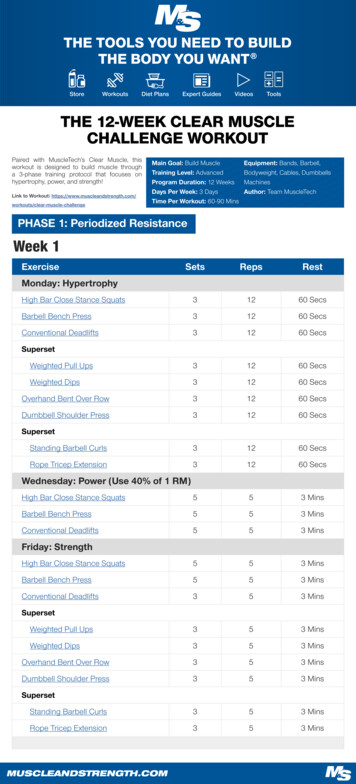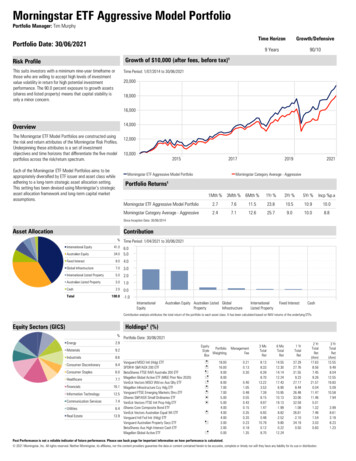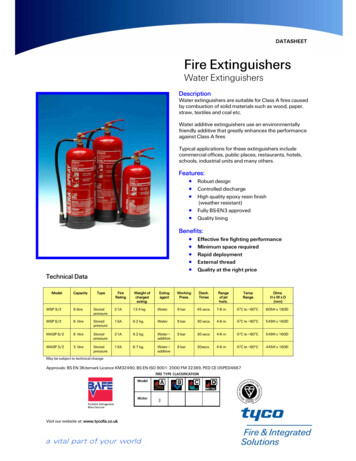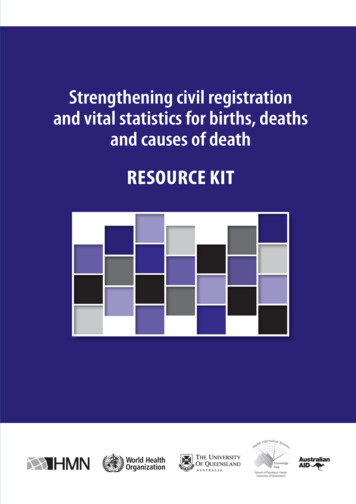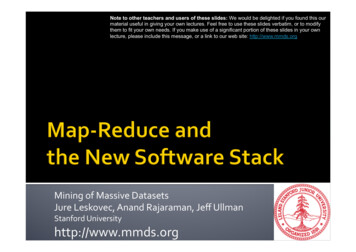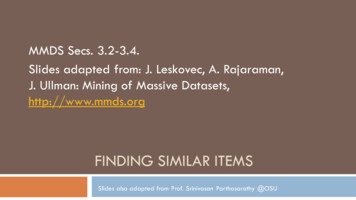
Transcription
MMDS Secs. 3.2-3.4.Slides adapted from: J. Leskovec, A. Rajaraman,J. Ullman: Mining of Massive Datasets,http://www.mmds.orgFINDING SIMILAR ITEMSSlides also adapted from Prof. Srinivasan Parthasarathy @OSU
Task: Finding Similar Documents Goal: Given a large number (𝑵 in the millions or billions) ofdocuments, find “near duplicate” pairsApplications:Mirror websites, or approximate mirrors remove duplicates Similar news articles at many news sites cluster 22
Task: Finding Similar Documents Goal: Given a large number (𝑵 in the millions or billions) ofdocuments, find “near duplicate” pairsApplications:Mirror websites, or approximate mirrors remove duplicates Similar news articles at many news sites cluster What are the challenges?23
Task: Finding Similar Documents Goal: Given a large number (𝑵 in the millions or billions) of documents,find “near duplicate” pairsApplications:Mirror websites, or approximate mirrors remove duplicates Similar news articles at many news sites cluster Problems:Many small pieces of one document can appear out of order in another Too many documents to compare all pairs Documents are so large or so many (scale issues) 24J. Leskovec, A. Rajaraman, J. Ullman: Mining of Massive Datasets, http://www.mmds.org
Two Essential Steps for Similar Docs1.2.Shingling: Convert documents to setsMin-Hashing: Convert large sets to short signatures, whilepreserving similarityHost of follow up applicationse.g. Similarity SearchData PlacementClustering etc.25J. Leskovec, A. Rajaraman, J. Ullman: Mining of Massive Datasets, http://www.mmds.org
The Big PictureSimilarity SearchData PlacementClustering etc.DocumentThe setof stringsof length kthat appearin the document26Signatures:short integervectors thatrepresent thesets, andreflect theirsimilarityJ. Leskovec, A. Rajaraman, J. Ullman: Mining of Massive Datasets, http://www.mmds.org
DocumentThe setof stringsof length kthat appearin the documentSHINGLINGStep 1: Shingling: Convert documents to sets
Documents as High-Dim Data Step 1: Shingling: Convert documents to sets Simple approaches:Document set of words appearing in document Document set of “important” words Don’t work well for this application. Why? 28Need to account for ordering of words!A different way: Shingles!J. Leskovec, A. Rajaraman, J. Ullman: Mining of Massive Datasets, http://www.mmds.org
Define: Shingles A k-shingle (or k-gram) for a document is a sequence of k tokensthat appears in the docTokens can be characters, words or something else, depending on theapplication Assume tokens characters for examples 29J. Leskovec, A. Rajaraman, J. Ullman: Mining of Massive Datasets, http://www.mmds.org
Define: Shingles A k-shingle (or k-gram) for a document is a sequence of k tokensthat appears in the docTokens can be characters, words or something else, depending on theapplication Assume tokens characters for examples 30Example: k 2; document D1 abcabSet of 2-shingles: S(D1) {ab, bc, ca}J. Leskovec, A. Rajaraman, J. Ullman: Mining of Massive Datasets, http://www.mmds.org
Define: Shingles A k-shingle (or k-gram) for a document is a sequence of k tokensthat appears in the docTokens can be characters, words or something else, depending on theapplication Assume tokens characters for examples Example: k 2; document D1 abcabSet of 2-shingles: S(D1) {ab, bc, ca} 31Another option: Shingles as a bag (multiset), count ab twice: S’(D1) {ab, bc, ca, ab}J. Leskovec, A. Rajaraman, J. Ullman: Mining of Massive Datasets, http://www.mmds.org
Shingles: How to treat white-space chars?It makes sense to replace any sequence of one or more white-space characters (blank, tab,newline, etc.) by a single blank.This way distinguishes shingles that cover two or more words from those that do not.32J. Leskovec, A. Rajaraman, J. Ullman: Mining of Massive Datasets, http://www.mmds.org
How to choose K? Documents that have lots of shingles in common have similar text,even if the text appears in different orderCaveat: You must pick k large enough, or most documents will havemost shinglesk 5 is OK for short documents k 10 is better for long documents 33J. Leskovec, A. Rajaraman, J. Ullman: Mining of Massive Datasets, http://www.mmds.org
Compressing Shingles To compress long shingles, we can hash them to (say) 4 bytesLike a Code Book If #shingles manageable Simple dictionary suffices e.g., 9-shingle bucket number [0, 2 32 - 1](using 4 bytes instead of 9)34J. Leskovec, A. Rajaraman, J. Ullman: Mining of Massive Datasets, http://www.mmds.org
Compressing Shingles To compress long shingles, we can hash them to (say) 4 bytesLike a Code Book If #shingles manageable Simple dictionary suffices Doc represented by the set of hash/dict. values of its k-shingles 35Idea: Two documents could appear to have shingles in common, when thehash-values were sharedJ. Leskovec, A. Rajaraman, J. Ullman: Mining of Massive Datasets, http://www.mmds.org
Compressing Shingles To compress long shingles, we can hash them to (say) 4 bytesLike a Code Book If #shingles manageable Simple dictionary suffices 36Doc represented by the set of hash/dict. values of its k-shinglesExample: k 2; document D1 abcabSet of 2-shingles: S(D1) {ab, bc, ca}Hash the singles: h(D1) {1, 5, 7}J. Leskovec, A. Rajaraman, J. Ullman: Mining of Massive Datasets, http://www.mmds.org
Similarity Metric for Shingles Document D1 is a set of its k-shingles C1 S(D1) Equivalently, each document is a 0/1 vector in the space of k-shingles Each unique shingle is a dimensionVectors are very sparseA natural similarity measure is the Jaccard similarity:sim(D1, D2) C1 C2 / C1 C2 37J. Leskovec, A. Rajaraman, J. Ullman: Mining of Massive Datasets, http://www.mmds.org
Motivation for Minhash/LSH Suppose we need to find similar documents among 𝑵 𝟏 milliondocumentsNaïvely, we would have to compute pairwise Jaccard similarities forevery pair of docs𝑵(𝑵 𝟏)/𝟐 5*1011 comparisons At 105 secs/day and 106 comparisons/sec,it would take 5 days 38For 𝑵 𝟏𝟎 million, it takes more than a year J. Leskovec, A. Rajaraman, J. Ullman: Mining of Massive Datasets, http://www.mmds.org
DocumentThe setof stringsof length kthat appearin the documentSignatures:short integervectors thatrepresent thesets, and reflecttheir similarityMINHASHINGStep 2: Minhashing: Convert large variable length sets toshort fixed-length signatures, while preserving similarity
Encoding Sets as Bit Vectors 40Many similarity problems can be formalized as finding subsets thathave significant intersectionJ. Leskovec, A. Rajaraman, J. Ullman: Mining of Massive Datasets, http://www.mmds.org
Encoding Sets as Bit Vectors Many similarity problems can be formalized as finding subsets thathave significant intersectionEncode sets using 0/1 (bit, boolean) vectors 41One dimension per element in the universal setInterpret set intersection as bitwise AND, andset union as bitwise ORJ. Leskovec, A. Rajaraman, J. Ullman: Mining of Massive Datasets, http://www.mmds.org
Encoding Sets as Bit Vectors Many similarity problems can be formalized as finding subsets thathave significant intersectionEncode sets using 0/1 (bit, boolean) vectors Interpret set intersection as bitwise AND, andset union as bitwise ORExample: C1 10111; C2 10011 42One dimension per element in the universal setSize of intersection 3; size of union 4,Jaccard similarity (not distance) 3/4Distance: d(C1,C2) 1 – (Jaccard similarity) 1/4J. Leskovec, A. Rajaraman, J. Ullman: Mining of Massive Datasets, http://www.mmds.org
From Sets to Boolean Matrices Rows elements (shingles)DocumentsColumns sets (documents) 43Note: Transposed Document Matrix1 in row e and column s if and only if e is a valid shingle ofdocument represented by sColumn similarity is the Jaccard similarity of the correspondingsets (rows with value 1)Typical matrix is sparse!Shingles 1110101100110001100111101010J. Leskovec, A. Rajaraman, J. Ullman: Mining of Massive Datasets, http://www.mmds.org
Outline: Finding Similar Columns So far:DocumentsA documents a set of shingles Represent a set as a boolean vector in a matrixShingles 441110101100110001100111101010J. Leskovec, A. Rajaraman, J. Ullman: Mining of Massive Datasets, http://www.mmds.org
Outline: Finding Similar Columns So far:DocumentsA documents a set of shingles Represent a set as a boolean vector in a matrix Next goal: Find similar columns while computingsmall signatures 45Similarity of columns similarity of signaturesShingles 1110101100110001100111101010J. Leskovec, A. Rajaraman, J. Ullman: Mining of Massive Datasets, http://www.mmds.org
Outline: Finding Similar Columns Next Goal: Find similar columns, Small signatures Naïve approach: 461) Signatures of columns: small summaries of columnsJ. Leskovec, A. Rajaraman, J. Ullman: Mining of Massive Datasets, http://www.mmds.org
Outline: Finding Similar Columns Next Goal: Find similar columns, Small signatures Naïve approach:1) Signatures of columns: small summaries of columns 2) Examine pairs of signatures to find similar columns 47Essential: Similarities of signatures and columns are related3) Optional: Check that columns with similar signatures are really similarJ. Leskovec, A. Rajaraman, J. Ullman: Mining of Massive Datasets, http://www.mmds.org
Outline: Finding Similar Columns Next Goal: Find similar columns, Small signatures Naïve approach:1) Signatures of columns: small summaries of columns 2) Examine pairs of signatures to find similar columns 3) Optional: Check that columns with similar signatures are really similarWarnings: Comparing all pairs may take too much time: Job for LSH 48Essential: Similarities of signatures and columns are relatedThese methods can produce false negatives, and even false positives (if the optional check isnot made)J. Leskovec, A. Rajaraman, J. Ullman: Mining of Massive Datasets, http://www.mmds.org
Hashing Columns (Signatures) : LSH principle Key idea: “hash” each column C to a small signature h(C), such that:(1) h(C) is small enough that the signature fits in RAM (2) sim(C1, C2) is the same as the “similarity” of signatures h(C1) and h(C2) 49J. Leskovec, A. Rajaraman, J. Ullman: Mining of Massive Datasets, http://www.mmds.org
Hashing Columns (Signatures) : LSH principle Key idea: “hash” each column C to a small signature h(C), such that:(1) h(C) is small enough that the signature fits in RAM (2) sim(C1, C2) is the same as the “similarity” of signatures h(C1) and h(C2) Goal: Find a hash function h(·) such that:If sim(C1,C2) is high, then with high prob. h(C1) h(C2) If sim(C1,C2) is low, then with high prob. h(C1) h(C2) 50J. Leskovec, A. Rajaraman, J. Ullman: Mining of Massive Datasets, http://www.mmds.org
Hashing Columns (Signatures) : LSH principle Key idea: “hash” each column C to a small signature h(C), such that:(1) h(C) is small enough that the signature fits in RAM (2) sim(C1, C2) is the same as the “similarity” of signatures h(C1) and h(C2) Goal: Find a hash function h(·) such that:If sim(C1,C2) is high, then with high prob. h(C1) h(C2) If sim(C1,C2) is low, then with high prob. h(C1) h(C2) 51Hash docs into buckets. Expect that “most” pairs of near duplicate docshash into the same bucket!J. Leskovec, A. Rajaraman, J. Ullman: Mining of Massive Datasets, http://www.mmds.org
Min-Hashing Goal: Find a hash function h(·) such that:if sim(C1,C2) is high, then with high prob. h(C1) h(C2) if sim(C1,C2) is low, then with high prob. h(C1) h(C2) Clearly, the hash function depends on the similarity metric: 52Not all similarity metrics have a suitable hash functionJ. Leskovec, A. Rajaraman, J. Ullman: Mining of Massive Datasets, http://www.mmds.org
Min-Hashing Goal: Find a hash function h(·) such that:if sim(C1,C2) is high, then with high prob. h(C1) h(C2) if sim(C1,C2) is low, then with high prob. h(C1) h(C2) Clearly, the hash function depends on the similarity metric: 53Not all similarity metrics have a suitable hash functionThere is a suitable hash function for the Jaccard similarity: It is calledMin-HashingJ. Leskovec, A. Rajaraman, J. Ullman: Mining of Massive Datasets, http://www.mmds.org
Min-Hashing 54Imagine the rows of the boolean matrix permuted under randompermutation J. Leskovec, A. Rajaraman, J. Ullman: Mining of Massive Datasets, http://www.mmds.org
Min-Hashing 55Imagine the rows of the boolean matrix permuted under randompermutation Define a “hash” function h (C) the index of the first (in thepermuted order ) row in which column C has value 1:h (C) min (C)J. Leskovec, A. Rajaraman, J. Ullman: Mining of Massive Datasets, http://www.mmds.org
Min-Hashing 56Imagine the rows of the boolean matrix permuted under randompermutation Define a “hash” function h (C) the index of the first (in thepermuted order ) row in which column C has value 1:h (C) min (C)Use several (e.g., 100) independent hash functions (that is,permutations) to create a signature of a columnJ. Leskovec, A. Rajaraman, J. Ullman: Mining of Massive Datasets, http://www.mmds.org
Min-Hashing 57Imagine the rows of the boolean matrix permuted under randompermutation Define a “hash” function h (C) the index of the first (in thepermuted order ) row in which column C has value 1:h (C) min (C)Use several (e.g., 100) independent hash functions (that is,permutations) to create a signature of a columnJ. Leskovec, A. Rajaraman, J. Ullman: Mining of Massive Datasets, http://www.mmds.org
Zoo example (shingle size k 1)Universe{ dog, cat, lion, tiger, mouse}[ cat, mouse, lion, dog, tiger][ lion, cat, mouse, dog, tiger]A { mouse, lion }58J. Leskovec, A. Rajaraman, J. Ullman: Mining of Massive Datasets, http://www.mmds.org
Zoo example (shingle size k 1)Universe{ dog, cat, lion, tiger, mouse}[ cat, mouse, lion, dog, tiger][ lion, cat, mouse, dog, tiger]A { mouse, lion }59mh1(A) min ({mouse, lion } ) mousemh2(A) min ({ mouse, lion } ) lionJ. Leskovec, A. Rajaraman, J. Ullman: Mining of Massive Datasets, http://www.mmds.org
Min-Hashing ExamplePermutation 60Input matrix (Shingles x ture matrix M2121J. Leskovec, A. Rajaraman, J. Ullman:Mining of Massive Datasets, http://www.mmds.org
Min-Hashing Example2nd element of the permutationis the first to map to a 1Permutation 61Input matrix (Shingles x ture matrix M2121J. Leskovec, A. Rajaraman, J. Ullman:Mining of Massive Datasets, http://www.mmds.org
Min-Hashing ExamplePermutation 62Input matrix (Shingles x Documents)Signature matrix M2 4101021213 2100121417 101016 301011 601015 710104 51010J. Leskovec, A. Rajaraman, J. Ullman:Mining of Massive Datasets, http://www.mmds.org
Min-Hashing Example2nd element of the permutationis the first to map to a 1Permutation 63Input matrix (Shingles x Documents)Signature matrix M2 4101021213 2100121417 101016 301011 601015 710104 510104th element of the permutationis the first to map to a 1J. Leskovec, A. Rajaraman, J. Ullman:Mining of Massive Datasets, http://www.mmds.org
Min-Hashing ExamplePermutation 64Input matrix (Shingles x Documents)Signature matrix M2 4 3101021213 2 4100121417 1 701011012126 3 2011 6 601015 7 110104 5 51010J. Leskovec, A. Rajaraman, J. Ullman:Mining of Massive Datasets, http://www.mmds.org
Note: Another (equivalent) way is tostore row indexesor raw shingles(e.g. mouse, lion):Min-Hashing Example1265341165342nd element of the permutationis the first to map to a 1Permutation 65Input matrix (Shingles x Documents)Signature matrix M2 4 3101021213 2 4100121417 1 701011012126 3 2011 6 601015 7 110104 5 510104th element of the permutationis the first to map to a 1J. Leskovec, A. Rajaraman, J. Ullman:Mining of Massive Datasets, http://www.mmds.org
Min-Hash Signatures Pick K 100 random permutations of the rowsThink of sig(C) as a column vectorsig(C)[i] according to the i-th permutation, the index of the firstrow that has a 1 in column Csig(C)[i] min ( i(C)) 66Note: The sketch (signature) of document C is small 𝟏𝟎𝟎 bytes!We achieved our goal! We “compressed” long bit vectors intoshort signaturesJ. Leskovec, A. Rajaraman, J. Ullman: Mining of Massive Datasets, http://www.mmds.org
Key FactFor two sets A, B, and a min-hash function mhi():Unbiased estimator for Sim using K hashes (notation policy – thisis a different K from size of shingle)67J. Leskovec, A. Rajaraman, J. Ullman: Mining of Massive Datasets, http://www.mmds.org
Min-Hashing ExamplePermutation 68Input matrix (Shingles x Documents)Signature matrix M2 4 3101021213 2 4100121417 1 701011012126 3 2011 6 601015 7 110104 5 51010Similarities:1-32-4 1-2Col/Col 0.75 0.75 0Sig/Sig 0.67 1.00 03-400J. Leskovec, A. Rajaraman, J. Ullman: Mining of Massive Datasets, http://www.mmds.org
The Min-Hash Property0000Choose a random permutation Claim: Pr[h (C1) h (C2)] sim(C1, C2)Why?11000110 One of the two cols had to have 1 atposition y69J. Leskovec, A. Rajaraman, J. Ullman: Mining of Massive Datasets, http://www.mmds.org
The Min-Hash Property0000Choose a random permutation Claim: Pr[h (C1) h (C2)] sim(C1, C2)Why?11000110 Let X be a doc (set of shingles), y X is a shingleOne of the two cols had to have 1 atposition y70J. Leskovec, A. Rajaraman, J. Ullman: Mining of Massive Datasets, http://www.mmds.org
The Min-Hash Property0000Choose a random permutation Claim: Pr[h (C1) h (C2)] sim(C1, C2)Why?11000110 Let X be a doc (set of shingles), y X is a shingleThen: Pr[ (y) min( (X))] 1/ X It is equally likely that any y X is mapped to the min elementOne of the two cols had to have 1 atposition y71J. Leskovec, A. Rajaraman, J. Ullman: Mining of Massive Datasets, http://www.mmds.org
The Min-Hash Property0000Choose a random permutation Claim: Pr[h (C1) h (C2)] sim(C1, C2)Why?11000110 Let X be a doc (set of shingles), y X is a shingleThen: Pr[ (y) min( (X))] 1/ X 72It is equally likely that any y X is mapped to the min elementLet y be s.t. (y) min( (C1 C2))Then either: (y) min( (C1)) if y C1 , or (y) min( (C2)) if y C2One of the two cols had to have 1 atposition yJ. Leskovec, A. Rajaraman, J. Ullman: Mining of Massive Datasets, http://www.mmds.org
The Min-Hash Property0000Choose a random permutation Claim: Pr[h (C1) h (C2)] sim(C1, C2)Why?11000110 Let X be a doc (set of shingles), y X is a shingleThen: Pr[ (y) min( (X))] 1/ X 73It is equally likely that any y X is mapped to the min elementLet y be s.t. (y) min( (C1 C2))Then either: (y) min( (C1)) if y C1 , or (y) min( (C2)) if y C2One of the two cols had to have 1 atposition ySo the prob. that both are true is the prob. y C1 C2Pr[min( (C1)) min( (C2))] C1 C2 / C1 C2 sim(C1, C2)J. Leskovec, A. Rajaraman, J. Ullman: Mining of Massive Datasets, http://www.mmds.org
The Min-Hash Property (Take 2: simpler proof) Choose a random permutation Claim: Pr[h (C1) h (C2)] sim(C1, C2)Why? Given a set X, the probability that any one element is the minhash under is 1/ X (0) It is equally likely that any y X is mapped to the min elementGiven a set X, the probability that one of any k elements is themin-hash under is k/ X (1) For C1 C2, the probability that any element is the min-hashunder is 1/ C1 C2 (from 0) (2) For any C1 and C2, the probability of choosing the same min-hashunder is C1 C2 / C1 C2 from (1) and (2) 74
Similarity for Signatures 75We know: Pr[h (C1) h (C2)] sim(C1, C2)Now generalize to multiple hash functionsThe similarity of two signatures is the fraction of the hash functions inwhich they agreeNote: Because of the Min-Hash property, the similarity of columns isthe same as the expected similarity of their signaturesJ. Leskovec, A. Rajaraman, J. Ullman: Mining of Massive Datasets, http://www.mmds.org
Min-Hashing ExamplePermutation 76Input matrix (Shingles x Documents)Signature matrix M2 4 3101021213 2 4100121417 1 701011012126 3 2011 6 601015 7 110104 5 51010Similarities:1-32-4 1-2Col/Col 0.75 0.75 0Sig/Sig 0.67 1.00 03-400J. Leskovec, A. Rajaraman, J. Ullman: Mining of Massive Datasets, http://www.mmds.org
Min-Hash Signatures Pick K 100 random permutations of the rowsThink of sig(C) as a column vectorsig(C)[i] according to the i-th permutation, the index of the firstrow that has a 1 in column Csig(C)[i] min ( i(C)) 77Note: The sketch (signature) of document C is small 𝟏𝟎𝟎 bytes!We achieved our goal! We “compressed” long bit vectors intoshort signaturesJ. Leskovec, A. Rajaraman, J. Ullman: Mining of Massive Datasets, http://www.mmds.org
Implementation Trick Permuting rows even once is prohibitive Approximate Linear Permutation Hashing Pick K independent hash functions (use a, b below) Apply the idea on each column (document) for each hash function and get minhash signatureHow to pick a randomhash function h(x)?Universal hashing:ha,b(x) ((a·x b) mod p) mod Nwhere:a,b random integersp prime number (p N)78J. Leskovec, A. Rajaraman, J. Ullman: Mining of Massive Datasets, http://www.mmds.org
Summary: 3 Steps Shingling: Convert documents to sets 79We used hashing to assign each shingle an IDMin-Hashing: Convert large sets to short signatures, whilepreserving similarity We used similarity preserving hashing to generate signatures withproperty Pr[h (C1) h (C2)] sim(C1, C2) We used hashing to get around generating random permutationsJ. Leskovec, A. Rajaraman, J. Ullman: Mining of Massive Datasets, http://www.mmds.org
80Backup slides
Outline: Finding Similar Columns So far:Documents Sets of shingles Represent sets as boolean vectors in a matrix Next goal: Find similar columns while computingsmall signatures 81Similarity of columns similarity of signaturesJ. Leskovec, A. Rajaraman, J. Ullman: Mining of Massive Datasets, http://www.mmds.org
Outline: Finding Similar Columns Next Goal: Find similar columns, Small signatures Naïve approach:1) Signatures of columns: small summaries of columns 2) Examine pairs of signatures to find similar columns 3) Optional: Check that columns with similar signatures are really similarWarnings: Comparing all pairs may take too much time: Job for LSH 82Essential: Similarities of signatures and columns are relatedThese methods can produce false negatives, and even false positives (if the optional check isnot made)J. Leskovec, A. Rajaraman, J. Ullman: Mining of Massive Datasets, http://www.mmds.org
Hashing Columns (Signatures) : LSH principle Key idea: “hash” each column C to a small signature h(C), such that:(1) h(C) is small enough that the signature fits in RAM (2) sim(C1, C2) is the same as the “similarity” of signatures h(C1) and h(C2) 83J. Leskovec, A. Rajaraman, J. Ullman: Mining of Massive Datasets, http://www.mmds.org
Hashing Columns (Signatures) : LSH principle Key idea: “hash” each column C to a small signature h(C), such that:(1) h(C) is small enough that the signature fits in RAM (2) sim(C1, C2) is the same as the “similarity” of signatures h(C1) and h(C2) Goal: Find a hash function h(·) such that:If sim(C1,C2) is high, then with high prob. h(C1) h(C2) If sim(C1,C2) is low, then with high prob. h(C1) h(C2) 84Hash docs into buckets. Expect that “most” pairs of near duplicatedocs hash into the same bucket!J. Leskovec, A. Rajaraman, J. Ullman: Mining of Massive Datasets, http://www.mmds.org
Min-Hashing Goal: Find a hash function h(·) such that:if sim(C1,C2) is high, then with high prob. h(C1) h(C2) if sim(C1,C2) is low, then with high prob. h(C1) h(C2) Clearly, the hash function depends on the similarity metric: 85Not all similarity metrics have a suitable hash functionThere is a suitable hash function for the Jaccard similarity: It is calledMin-HashingJ. Leskovec, A. Rajaraman, J. Ullman: Mining of Massive Datasets, http://www.mmds.org
Min-Hashing 86Imagine the rows of the boolean matrix permuted under randompermutation Define a “hash” function h (C) the index of the first (in thepermuted order ) row in which column C has value 1:h (C) min (C)Use several (e.g., 100) independent hash functions (that is,permutations) to create a signature of a columnJ. Leskovec, A. Rajaraman, J. Ullman: Mining of Massive Datasets, http://www.mmds.org
Zoo example (shingle size k 1)Universe{ dog, cat, lion, tiger, mouse}[ cat, mouse, lion, dog, tiger][ lion, cat, mouse, dog, tiger]A { mouse, lion }87mh1(A) min ({mouse, lion } ) mousemh2(A) min ({ mouse, lion } ) lionJ. Leskovec, A. Rajaraman, J. Ullman: Mining of Massive Datasets, http://www.mmds.org
Key FactFor two sets A, B, and a min-hash function mhi():Unbiased estimator for Sim using K hashes (notation policy – thisis a different K from size of shingle)88J. Leskovec, A. Rajaraman, J. Ullman: Mining of Massive Datasets, http://www.mmds.org
Note: Another (equivalent) way is tostore row indexesor raw shingles(e.g. mouse, lion):Min-Hashing Example1265341165342nd element of the permutationis the first to map to a 1Permutation 89Input matrix (Shingles x Documents)Signature matrix M2 4 3101021213 2 4100121417 1 701011012126 3 2011 6 601015 7 110104 5 510104th element of the permutationis the first to map to a 1J. Leskovec, A. Rajaraman, J. Ullman:Mining of Massive Datasets, http://www.mmds.org
The Min-Hash Property0000Choose a random permutation Claim: Pr[h (C1) h (C2)] sim(C1, C2)Why?11000110 Let X be a doc (set of shingles), y X is a shingleThen: Pr[ (y) min( (X))] 1/ X 90It is equally likely that any y X is mapped to the min elementLet y be s.t. (y) min( (C1 C2))Then either: (y) min( (C1)) if y C1 , or (y) min( (C2)) if y C2So the prob. that both are true is the prob. y C1 C2Pr[min( (C1)) min( (C2))] C1 C2 / C1 C2 sim(C1, C2)One of the two cols had to have 1 atposition yJ. Leskovec, A. Rajaraman, J. Ullman: Mining of Massive Datasets, http://www.mmds.org
The Min-Hash Property (Take 2: simpler proof) Choose a random permutation Claim: Pr[h (C1) h (C2)] sim(C1, C2)Why? Given a set X, the probability that any one element is the minhash under is 1/ X (0) It is equally likely that any y X is mapped to the min elementGiven a set X, the probability that one of any k elements is themin-hash under is k/ X (1) For C1 C2, the probability that any element is the min-hashunder is 1/ C1 C2 (from 0) (2) For any C1 and C2, the probability of choosing the same min-hashunder is C1 C2 / C1 C2 from (1) and (2) 91
Similarity for Signatures 92We know: Pr[h (C1) h (C2)] sim(C1, C2)Now generalize to multiple hash functionsThe similarity of two signatures is the fraction of the hash functions inwhich they agreeNote: Because of the Min-Hash property, the similarity of columns isthe same as the expected similarity of their signaturesJ. Leskovec, A. Rajaraman, J. Ullman: Mining of Massive Datasets, http://www.mmds.org
Min-Hashing ExamplePermutation 93Input matrix (Shingles x Documents)Signature matrix M2 4 3101021213 2 4100121417 1 701011012126 3 2011 6 601015 7 110104 5 51010Similarities:1-32-4 1-2Col/Col 0.75 0.75 0Sig/Sig 0.67 1.00 03-400J. Leskovec, A. Rajaraman, J. Ullman: Mining of Massive Datasets, http://www.mmds.org
Min-Hash Signatures Pick K 100 random permutations of the rowsThink of sig(C) as a column vectorsig(C)[i] according to the i-th permutation, the index of the firstrow that has a 1 in column Csig(C)[i] min ( i(C)) 94Note: The sketch (signature) of document C is small 𝟏𝟎𝟎 bytes!We achieved our goal! We “compressed” long bit vectors intoshort signaturesJ. Leskovec, A. Rajaraman, J. Ullman: Mining of Massive Datasets, http://www.mmds.org
Implementation Trick Permuting rows even once is prohibitive Approximate Linear Permutation Hashing Pick K independent hash functions (use a, b below) Apply the idea on each column (document) for each hash function and get minhash signatureHow to pick a randomhash function h(x)?Universal hashing:ha,b(x) ((a·x b) mod p) mod Nwhere:a,b random integersp prime number (p N)95J. Leskovec, A. Rajaraman, J. Ullman: Mining of Massive Datasets, http://www.mmds.org
Summary: 3 Steps Shingling: Convert documents to sets We used hashing to assign each shingle an IDMin-Hashing: Convert large sets to short signatures, whilepreserving similarityWe used similarity preserving hashing to generate signatures withproperty Pr[h (C1) h (C2)] sim(C1, C2) We used hashing to get around generating random permutations 96J. Leskovec, A. Rajaraman, J. Ullman: Mining of Massive Datasets, http://www.mmds.org
97Backup slides
35 Compressing Shingles To compress long shingles, we can hash them to (say) 4 bytes Like a Code Book If #shingles manageable Simple dictionary suffices Doc represented by the set of hash/dict. values of its k-shingles Idea: Two documents could appear to have shingles in common, when the hash-values were shared
